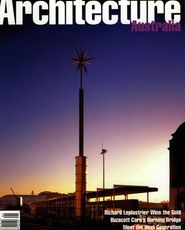| Noting new books at Architext |
 | GABRIEL POOLE: SPACE IN WHICH
THE SOUL CAN PLAY Shining through the first (biographical) section is Walker’s refreshing disconnection from that dodgy notion often inflicted on architecture innocents—that the architect’s persona must remain opaque because the work has to be considered in isolation. So instead of constantly resorting to euphemisms to obscure comprehension of the character, Walker lets it almost all hang out: the rebellious toddler, the war-torn childhood at a hated boarding school, the tortured jackaroo who thought he was “a bloody idiot” and the emotional pains of a respectable marriage which he abandoned disgracefully for the charms of a client’s daughter who has patiently calmed him over 25 years of financial uncertainty. Although a positive bias is often evident in Walker’s biography, readers will appreciate his extensive research and interviews with Poole connoisseurs like his mother, Zelma Dyson, proteges Lindsay and Kerry Clare and John Mainwaring, and critic-historian Jennifer Taylor. The book’s second section, which documents 40 projects, is marred by some lamentable amateur slides—a fact of life, unfortunately, because these are the only records of his early houses. However, designer Kirk Palmer’s smart typography and elegant page layouts do much to rescue this setback. The last two sections explore Poole’s design philosophy and explain his impact on Australian architecture. Perhaps here, Walker’s lack of immersion in architecture’s history and metaphysical pretensions lets his readers down a bit—another writer might have inserted Poole (probably kicking and screaming) into a theoretical picture. That quibble doesn’t diminish this volume’s interest value, nor its importance as the only decent record yet of a crucial figure in Australia’s architectural development. BUILDING 8: EDMOND & CORRIGAN
AT RMIT [B8 E&C]
This unusually generous record of one building (more pages than Haig Beck’s boxed book on Parliament House, Canberra) begins with Volume 1: 10 Essays—a suite of interesting, esoteric interpretations from Peter Kohane, Philip Goad, Craig Bremner, Jennifer Hocking, Alex Selenitsch, Peter King and editors Bertram and van Schaik. | Volume 2: Design Developmentoffers dense pictorial coverage of the early sketches, models, working drawings and agitated polychrome outcomes of the E&C (design) and Demaine (documentation) collaboration. Volume 3: The Writings of Maggie Edmond & Peter Corriganis less directly relevant to the project than the other volumes but is a more intriguing exploration of this pair’s recent intellectual trajectory as spelt out in print. There are indications here that Corro might have touched some nerves as a novelist. FROM WATTLE & DAUB TO CONCRETE & STEEL: THE ENGINEERING HISTORY OF AUSTRALIA’S BUILDINGS By Henry J. Cowan, Melbourne University Press, $50. Instead of fluffing around in retirement, engineer Henry Cowan, a former Dean of Architecture at the University of Sydney and honorary fellow of the RAIA, has researched this worthy textbook to outline Australia’s history of building. His emphasis is not on design but materials, technologies and services. Readers are delivered a brisk and illuminating overview of how our built environment has advanced from the tents of the First Fleeters (1780s) to candle-lighting produced from boiled-down animal carcasses (1850s) to Australia’s first hydraulic lift in a six-storey Melbourne building (1884) to the tube-in-tube prefabricated concrete system exploited by Harry Seidler for Sydney’s MLC Tower (1974) and modern curtain walls of heat and light-responsive glass (discussed up to the 1980s). Uni students are bound to find this helpful for their construction assignments. MANUALS AND CATALOGUES Notices by Davina Jackson. Architext bookshops are at Tusculum, Sydney, ph 02 9356 2022 and 41 Exhibition Street, Melbourne, ph 03 9650 3474 |















